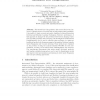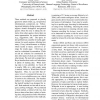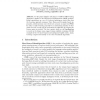80 search results - page 7 / 16 » Simple Features for Chinese Word Sense Disambiguation |
TAL
2004
Springer
14 years 1 days ago
2004
Springer
This paper presents an algorithm to apply the smoothing techniques described in [1] to three different Machine Learning (ML) methods for Word Sense Disambiguation (WSD). The method...
NLDB
2005
Springer
14 years 6 days ago
2005
Springer
Abstract. Automated Text Categorization has reached the levels of accuracy of human experts. Provided that enough training data is available, it is possible to learn accurate autom...
EMNLP
2009
13 years 4 months ago
2009
Three methods are proposed to classify queries by intent (CQI), e.g., navigational, informational, commercial, etc. Following mixed-initiative dialog systems, search engines shoul...
CORR
2000
Springer
13 years 6 months ago
2000
Springer
In this paper Schapire and Singer's AdaBoost.MH boosting algorithm is applied to the Word Sense Disambiguation (WSD) problem. Initial experiments on a set of 15 selected polys...
COLING
2000
13 years 8 months ago
2000
In this paper, word sense dismnbiguation (WSD) accuracy achievable by a probabilistic classifier, using very milfimal training sets, is investigated. \Ve made the assuml)tiou that...



